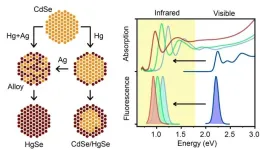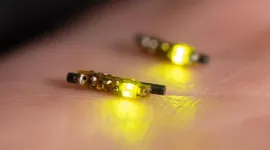(Press-News.org) LA JOLLA, CA—Even years after they have recovered, a person who once struggled with alcohol or opioid addiction can relapse—and that relapse is more likely to occur during particularly stressful times. Now, Scripps Research scientists have identified an area of the brain that plays a key role in stress-induced oxycodone relapse. Their findings explain why the drug suvorexant, which they previously found to reduce alcohol and oxycodone relapse when administered orally, works so well.
“Having a better understanding of the region(s) in the brain responsible for this kind of relapse is incredibly important as we develop treatments for alcohol use disorder and opioid use disorder,” says Scripps Research Associate Professor Remi Martin-Fardon, PhD, senior author of the study published in Journal of Psychopharmacology.
Alcohol use disorder includes chronic heavy alcohol use and binge drinking, while opioid use disorder is the chronic use of opioids that causes significant distress or impairment. Both disorders are considered major public health concerns and affect millions of people a year.
Recently, Martin-Fardon’s team showed that when alcohol-dependent rats were given the drug suvorexant (Belsomra®), they drank less alcohol and were less likely to experience stress-induced relapse. Similar experiments suggested that it also could prevent opioid relapse elicited by drug-associated cues.
Suvorexant blocks the neuronal signaling chemical orexin. But orexin acts on the brain in multiple ways, and the researchers wanted to better understand which areas of the brain and molecular pathways were responsible for suvorexant’s effect on relapse.
In the new study, the researchers focused on opioid-dependent rats that had learned to press a lever to receive oxycodone but then were abstinent from the opioid for at least 8 days.
Then, the researchers developed a system to expose only one small area of the rats’ brains, known as the posterior paraventricular nucleus of the thalamus (pPVT), to suvorexant, rather than giving the drug orally which exposes the entire brain to the drug. The pPVT has been previously shown to play a role in stress, eating and drinking. They found that opioid-dependent rats who were exposed to stress and exposed to suvorexant in the pPVT, pressed the opioid-delivering lever less than half as many times as untreated rats. This diminished drug-seeking behavior, even in the face of stress, showed that suvorexant’s ability to prevent relapse was due to its action on orexin signaling in the pPVT.
“In the past, there has been a lot of focus on the role of other areas of the brain in stress-induced relapse,” says Jessica Illenberger, a postdoctoral research fellow at Scripps Research and first author of the new paper. “Our work really points the finger at the pPVT, as well as orexin signaling in that brain region, as being important in stress processing and drug-seeking behavior.”
Importantly, when the animals were given sweetened condensed milk instead of oxycodone, or when they were reintroduced to drug-associated cues instead of stress, suvorexant in the pPVT did not change their behavior. This suggests that stress-induced oxycodone relapse is mediated by different molecular drivers than stress-induced sugar cravings or other types of oxycodone relapse.
“Relapse is a huge problem for people with opioid use disorder and alcohol use disorder and this gets us one step closer to identifying the proper types of treatment to reduce the risk of relapse,” says Illenberger.
The team is now carrying out similar experiments in animal models to determine whether suvorexant also acts through the pPVT in cases of alcohol dependence.
In addition to Martin-Fardon and Illenberger, authors of the study, “Pivotal role of orexin signaling in the posterior paraventricular nucleus of the thalamus during the stress-induced reinstatement of oxycodone-seeking behavior,” include Francisco Flores-Ramirez, Glenn Pascasio, Marissa Franco and Brandon Mendonsa of Scripps Research.
This work was supported by the National Institutes of Health (AA026999, AA028549, AA006420, T32 AA007456, DA053443).
END
Researchers identify brain region involved in oxycodone relapse
Study by Scripps Research scientists suggests future therapies for opioid and alcohol addiction.
2024-07-10
ELSE PRESS RELEASES FROM THIS DATE:
Daily sugar intake fell by 5 g in kids + 11 g in adults year after UK sugar tax imposition
2024-07-10
Daily sugar intake fell by around 5 g in children and by around 11 g in adults in the 12 months following the introduction of the UK’s ‘sugar tax’, formally known as the Soft Drinks Industry Levy, finds an analysis of 11 years of survey data, published online in the Journal of Epidemiology & Community Health.
The sugar from soft drinks alone made up over half this total, the estimates suggest. But overall daily energy intake from free sugars levels are still higher than the updated recommendation from the World Health Organisation (WHO) of 5%---equivalent to 30 g/day for adults, 24 g for 7–10 year olds, and 19 g for 4–6 year olds—point ...
Osteoarthritis may double risk of speedy progression to severe multimorbidity
2024-07-10
Osteoarthritis—a condition in which the protective cartilage on the ends of bones breaks down—may more than double the risk of speedy progression to accumulating severe long term conditions (multimorbidity), finds a 20 year study published in the open access journal RMD Open.
And there seem to be 4 different speeds of progression to multimorbidity, the findings indicate.
Persistently low levels of physical activity, a high calorie diet, plus chronic low grade inflammation may help to explain the link between osteoarthritis and the risk of accumulating other long term conditions, suggest the researchers.
Although the exact causes aren’t known, injury, age, family ...
Researchers listen to the hearts of bats in flight
2024-07-10
Researchers from Konstanz have measured the heart rate of bats over several days in the wild, including complete flights—the first time this has been done for a bat species. To record the heart rate of male common noctule bats during flight, the scientists attached heart rate transmitters weighing less than one gram to the animals, which they then accompanied in an airplane while the bats flew, sometimes for more than an hour, in search of food. Their results, published in Proceedings of the Royal Society B, show how much energy bats consume over the course of a day and what energy-saving strategies they ...
Familial endocrine diseases linked to increased risk of pregnancy loss, new research shows
2024-07-10
Women who have close family members with endocrine diseases, including type 2 diabetes, thyroid diseases and polycystic ovary syndrome (PCOS), are at higher risk of pregnancy loss, a new study has found [1].
The research, presented today at the ESHRE 40th Annual Meeting in Amsterdam, examined the association between various endocrine diseases and the incidence of pregnancy loss. The study investigated 366,539 women in Denmark between 1973 and 2022.
The study found that women with parents diagnosed with endocrine diseases faced a 6% higher risk of pregnancy loss ...
Health AI expert Nathan Price joins Buck faculty
2024-07-09
The Buck Institute for Research on Aging announces the appointment of Nathan Price, PhD, to Professor and Co-Director of the Center for Human Healthspan. Price specializes in systems biology, artificial intelligence, and bioengineering. He has published more than 200 scientific papers and is co-author, with Buck Chief Innovation Officer and Distinguished Professor Lee Hood, of “The Age of Scientific Wellness.” Price has been named one of 10 Emerging Leaders in Health and Medicine by the National Academy of Medicine and is a member of the Board on Life Sciences of the National Academies of Sciences, Engineering, and Medicine.
Dr. Price is Chief Scientific Officer ...
Greater focus needed on how existing international law can prevent the increasing militarisation of outer space
2024-07-09
There is a pressing need for countries and international organisations to understand better how existing international law can help them address serious concerns about the militarisation of outer space, a new study says.
Space ...
Found with Webb: a potentially habitable icy world
2024-07-09
A international team of astronomers led by Université de Montréal has made an exciting discovery about the temperate exoplanet LHS 1140 b: it could be a promising "super-Earth" covered in ice or water.
When the exoplanet LHS 1140 b was first discovered, astronomers speculated that it might be a mini-Neptune: an essentially gaseous planet, but very small in size compared to Neptune. But after analyzing data from the James Webb Space Telescope (JWST) collected in December 2023 - combined with previous data from other space telescopes such as Spitzer, Hubble and ...
New one-step method to make multiple edits to a cell’s genome
2024-07-09
SAN FRANCISCO, CA—Genome editing has become a widely adopted technology to modify DNA in cells, allowing scientists to study diseases in the lab and develop therapies that repair disease-causing mutations. However, with current approaches, it’s only possible to edit cells in one location at a time.
Now, a team of scientists at Gladstone Institutes has developed a new method that enables them to make precise edits in multiple locations within a cell—all at once. Using molecules called retrons, they created a tool that can efficiently modify DNA in bacteria, yeast, and human cells.
“We wanted to push the boundaries of genomic technologies ...
Moving from the visible to the infrared: Developing high quality nanocrystals
2024-07-09
Awarded the 2023 Nobel Prize in Chemistry, quantum dots have a wide variety of applications ranging from displays and LED lights to chemical reaction catalysis and bioimaging. These semiconductor nanocrystals are so small—on the order of nanometers—that their properties, such as color, are size dependent, and they start to exhibit quantum properties. This technology has been really well developed, but only in the visible spectrum, leaving untapped opportunities for technologies in both the ultraviolet and infrared regions of the electromagnetic ...
Implantable LED device uses light to treat deep-seated cancers
2024-07-09
Certain types of light have proven to be an effective, minimally invasive treatment for cancers located on or near the skin when combined with a light-activated drug. But deep-seated cancers, surrounded by tissue, blood and bone, have been beyond the reach of light’s therapeutic effects.
To bring light’s benefits to these harder-to-access cancers, engineers and scientists at the University of Notre Dame have devised a wireless LED device that can be implanted. This device, when combined with a light-sensitive ...
LAST 30 PRESS RELEASES:
UVA’s Jundong Li wins ICDM’S 2025 Tao Li Award for data mining, machine learning
UVA’s low-power, high-performance computer power player Mircea Stan earns National Academy of Inventors fellowship
Not playing by the rules: USU researcher explores filamentous algae dynamics in rivers
Do our body clocks influence our risk of dementia?
Anthropologists offer new evidence of bipedalism in long-debated fossil discovery
Safer receipt paper from wood
Dosage-sensitive genes suggest no whole-genome duplications in ancestral angiosperm
First ancient human herpesvirus genomes document their deep history with humans
Why Some Bacteria Survive Antibiotics and How to Stop Them - New study reveals that bacteria can survive antibiotic treatment through two fundamentally different “shutdown modes”
UCLA study links scar healing to dangerous placenta condition
CHANGE-seq-BE finds off-target changes in the genome from base editors
The Journal of Nuclear Medicine Ahead-of-Print Tip Sheet: January 2, 2026
Delayed or absent first dose of measles, mumps, and rubella vaccination
Trends in US preterm birth rates by household income and race and ethnicity
Study identifies potential biomarker linked to progression and brain inflammation in multiple sclerosis
Many mothers in Norway do not show up for postnatal check-ups
Researchers want to find out why quick clay is so unstable
Superradiant spins show teamwork at the quantum scale
Cleveland Clinic Research links tumor bacteria to immunotherapy resistance in head and neck cancer
First Editorial of 2026: Resisting AI slop
Joint ground- and space-based observations reveal Saturn-mass rogue planet
Inheritable genetic variant offers protection against blood cancer risk and progression
Pigs settled Pacific islands alongside early human voyagers
A Coral reef’s daily pulse reshapes microbes in surrounding waters
EAST Tokamak experiments exceed plasma density limit, offering new approach to fusion ignition
Groundbreaking discovery reveals Africa’s oldest cremation pyre and complex ritual practices
First breathing ‘lung-on-chip’ developed using genetically identical cells
How people moved pigs across the Pacific
Interaction of climate change and human activity and its impact on plant diversity in Qinghai-Tibet plateau
From addressing uncertainty to national strategy: an interpretation of Professor Lim Siong Guan’s views
[Press-News.org] Researchers identify brain region involved in oxycodone relapseStudy by Scripps Research scientists suggests future therapies for opioid and alcohol addiction.





